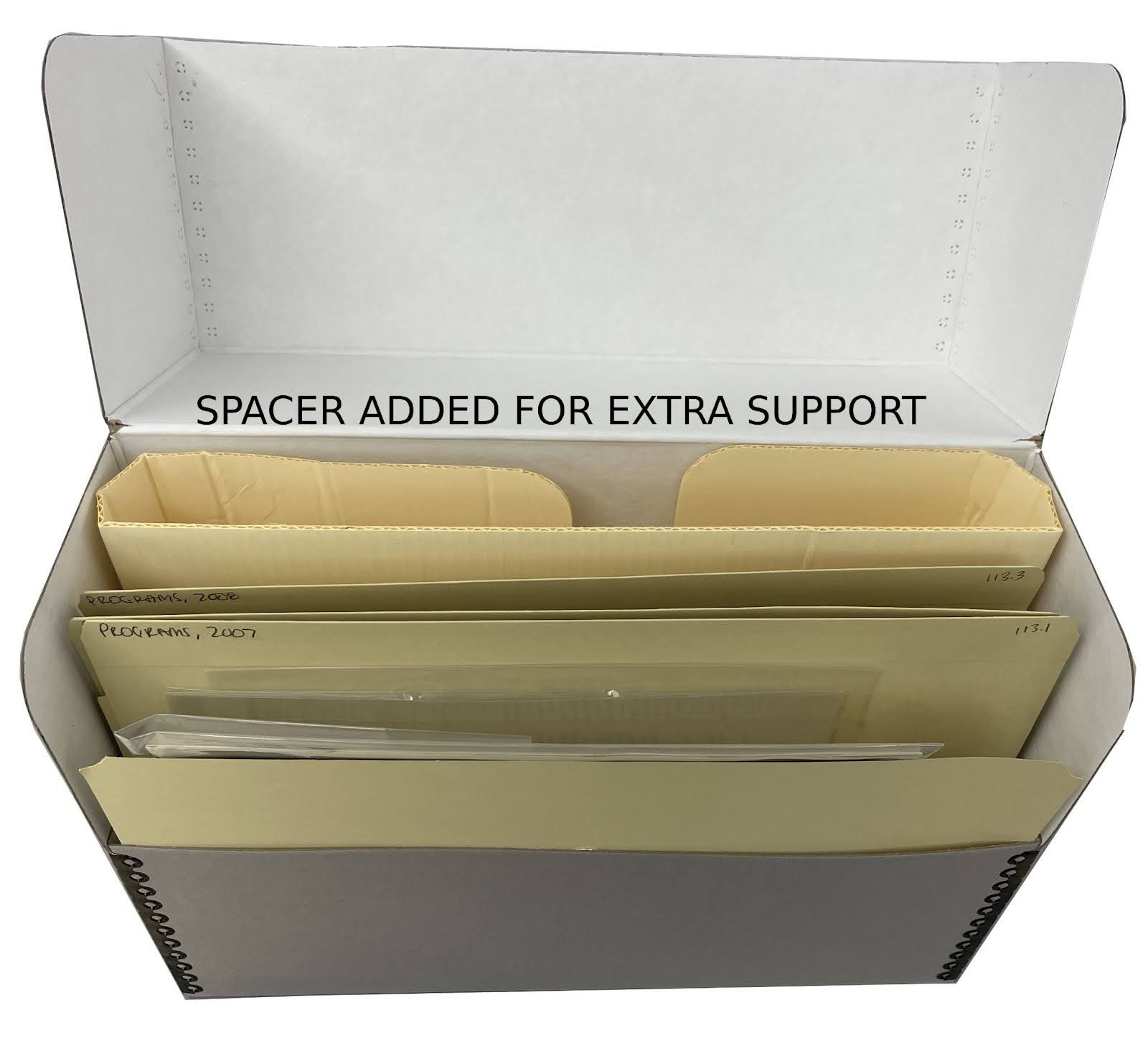Boxes
When a collection is received in the Archival Processing unit, the Collection Manager will rehouse materials into containers that fit onto shelves. The most common container type for new acquisitions is a record carton. Collections that arrive housed in archivally safe, acid-free boxes can be kept in their original containers. However, even though a record carton is considered safe and suitable for long-term storage, it is more challenging for reading room staff to retrieve, and for researchers to use. Collection materials stored in record cartons should almost always be rehoused into a legal-size document box or other standard size archival box. If a collection is stored in old, damaged, or unstable containers, then rehousing will always be necessary.
To promote order and cleanliness, and reduce the impact on our facilities staff, please always break down your boxes before recycling. Additionally, while some archival boxes can be reused, refrain from keeping boxes that have extraneous labels or writing that cannot be easily covered or removed. For example, if a flat box has multiple labels on each side, is marked up in permanent ink, or is in poor condition, it should be recycled, as it cannot be reused for a new collection.
Legal-size document boxes are the standard box used for most collections. Letter-size folders can go into legal size boxes if re-foldering is not necessary. If an item can fit in a legal document box, it should not be placed in an oversized or flat container; this practice will keep the records snug and prevent damage during movement. Take care to only include one size of folder in a single box, the exception being a legal-size document box, which can accommodate both legal and letter size folders. Oversized items will require an appropriately-sized flat box, folder, or tube. See the section of this documentation on oversized material for more information.
Improperly housing collections can undo all the work expended on preserving documents. If a box is packed too loosely, folders may shift when the box is moved, and the folders may bend or open allowing the materials within them to curl and slump. If a box is too full, documents may bend, tear, or crease.
Guidelines for Housing Collection Material in Boxes
This section provides housing guidelines for common scenarios in the Archival processing unit. If you are unsure about the best way to house a particular item in your collection, ask your supervisor.
Intellectual Arrangement and Physical Arrangement Boxes may contain more than one series. The physical order in the box may differ from the order in the finding aid.
Legal Document Boxes are the Preferred Standard Even if a collection is received in letter-size folders, they should usually be placed into a legal-size document box. A legal-sized document box can house both legal and letter folders.
Volumes Volumes that can comfortably fit, should be placed in folders, and filed spine-down in document boxes. If the volumes are fragile, large, or in poor condition, consult you may need to coordinate with collections care to make a custom box.
Do Not Overfill Boxes If the box is bulging and the flip-top lid cannot be easily lowered, remove folders until the box closes and the content is secure.
Take care to ensure a box is not too heavy. Remember that reading room staff will have to move these boxes off carts and shelves. If the box is too heavy, it is also likely too full.
If you cannot easily remove a folder from the box, then the box is too full. Researchers should be able to easily remove and return a folder to the box without it getting stuck, damaged, or affecting the other folders. If you can comfortably place your hand behind the last folder in the box, without too little or too much space, then the box contains just the right amount of material. See the example image below.

If there are not enough folders to fill the final box, place a rigid acid-free spacer, appropriately configured, behind the last folder. See the example image below.

Flat Boxes Should Only Contain One Folder Size Each flat box should contain only one size folder and the folder should be specific to the box size. For example, a 19” x 25” box should only contain 19” x 25” folders. It is okay to put a slightly smaller item into a larger folder in a flat box. Smaller or larger sized folders than the dimensions of a single box may cause damage to the materials during handling and transit.
Numbering Boxes As you fill archival boxes, number boxes consecutively throughout the collection; do not restart box numbers with each series or subseries. This will keep the collection accessible and in order while you process. There are different ways to do this, as each archivists’ method varies. One suggestion is to label each box with a post-it note, identifying the name of the collection and box number. Another suggestion is to write lightly in pencil at the location where each box will be labeled later, therefore you don’t have to take time to erase.
Additionally, do not use prefixes or suffixes when adding new boxes. Use the next consecutive box number available in the collection.